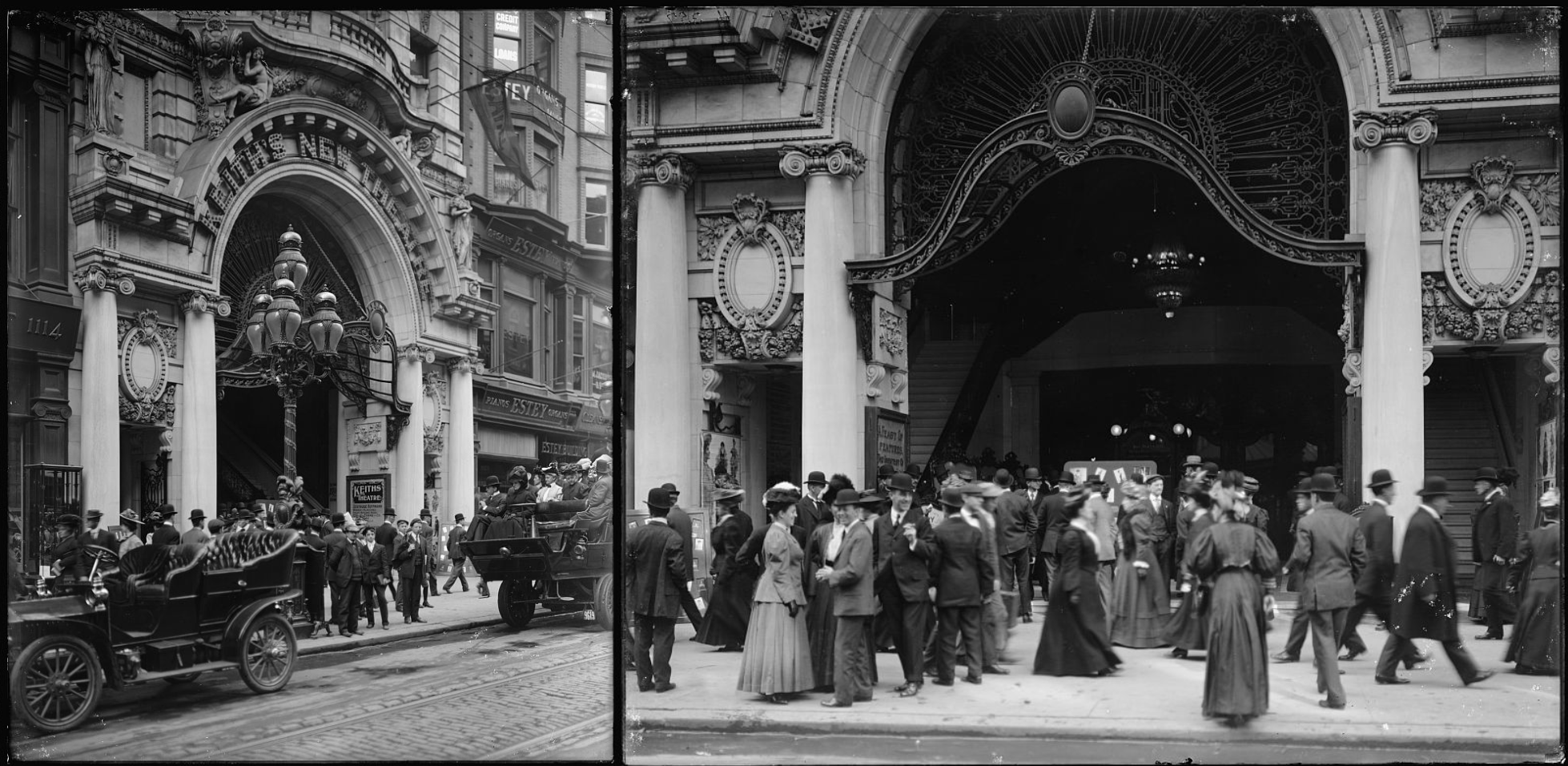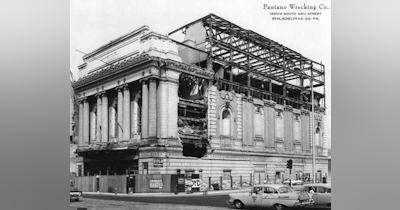Above, the cover for the sheet music for "The Philadelphia Drag," as it was performed by a chorus - including a young Mae West (left) at the Folies Bergere Revue in 1911. And here's the clipping from a Philly newspaper announcing her subsequent booking in the Liberty Theatre in North Philadelphia:
The photos below, from the collection of the Library of Congress, are some of the most commonly shared images of Keith's New Theatre at 1116 Chestnut Street, the grandest vaudeville theater ever built in the city. Taken in 1902 on its opening day, we can see the people bustling about the entrance, going to buy tickets or looking at the posted photos of the acts on the bill that day.
The large number of so many well-dressed women in the photos is significant. As we mention in the podcast, the appeal of vaudeville was that it was "respectable" and therefore not lewd or vulgar. Though in later years the word "vaudeville" called up associations with something hammy and old-fashioned, we ought to remember that once it was exciting and modern.
Speaking of well-dressed women, here's a publicity photo of Yvette Guilbert, as she appeared at Keith's Theatre in November of 1909. Next to it is a caricature of the French singer which was printed in the Inquirer:

Below, the interior of Keith's, showing the orchestra seats and the tiers of boxes on the right hand side of the audience. I call everyone's attention to the ornamental caryatid figures on the top, there. The Keith organization was know for its prudishness (performers couldn't even say "gosh!" or "holy gee!" in their acts). But here we can certainly see a lot of naked female forms in the in statuary, in plain view of the entire crowd. But then again this was supposed to be respectable "Advanced" vaudeville - in addition to attracting large crowds of common folks, the owners also wanted to host the same sort of people who went to opera. So maybe they were trying to make it rather like the Academy of Music, a few blocks away, which has similar figures adorning its interior.
To give you an ideal of its luxuriousness, underneath is another gorgeous black-and-white photo of one of the Keith's lobby (looking out towards the front doors), and then some vintage colored picture postcards of Keith's.
Again, note the boards with all the photos of the performers on display out front and in the lobbies! These display boards were especially important for lesser-known acts on the bill, who were trying to introduce themselves to the public as they came in. The "headliner" on the bill got their name up in lights across the front entrance. The photo for the postcard on the left must have been taken in 1912, because that is when the British actress Ada Reeve came through Philadelphia. Her singing act was typical of English music hall performers, full of all sorts of double entendres and sexual innuendoes that American female signers would never have got away with. But because she was 'foreign' it was regarded as classy and sophisticated, I guess.
Above is a photo of Keith's at night, all lit up on the evening of May 15, 1917. The headliner advertised was Julia Arthur (1869-1950), the accomplished Canadian-American actress. Miss Arthur was appearing in "Liberty Aflame," a patriotic spectacle penned by the playwright Roland Burke Hennessy, that featured her as the Statue of Liberty.
The other act being featured that week was "The Edge of the World" - a sound and light display - "a remarkable exhibition of futuristic color" reported the Inquirer, "As if one were looking through an immense kaleidoscope, the colors never appearing in the same fantastic formations and shades a second time."
In our episode on theater fires, we talked about Philadelphia variety performance venues that burned down during the 19th Century: Vauxhall Gardens on Broad Street, Barnum’s Museum on Chestnut Street, Fox’s American Theatre, Sanford’s Opera House - these were all home to variety entertainment. And in Episode 30, “The Best of Times,” we covered the construction of the first theater that was specifically built for vaudeville: Keith’s Bijou on Arch Street, which had hosted one the first exhibitions of those new-fangled moving pictures in an American theater, starting in 1897.
Below is the facade of that original Keith-Albee theater in Philadelphia, constructed in 1892, and you can see the little dancing namesake fairies painted on the windows above the front entrance. Here the very first movies ever shown in Philadelphia were exhibited in 1896. After it was superseded by Keith's New Theatre on Chestnut in 1902, the older Bijou on Arch switched to hosting stock company comedies and melodramas, and then - as the neighborhood got increasingly seedy - became a burlesque house. By the 40s and 50s it was showing "B movies" and was not well-maintained. It was finally torn down in 1967.
Here's the 1200-seat Orpheum on Chelten Avenue in Germantown. It stood from 1912 to 1967:
The William Penn Theatre was in West Philadelphia . . . .
. . . as was the Nixon Theatre built in 1910 at 34 S. 52nd St. At first the site of a large vaudeville tent theater, this 1900-seat auditorium was later constructed with marble-lined lobbies and crystal chandeliers welcomed audience members paying as little as ten cents for admission. A 42-foot wide stage with a 33-foot high proscenium arch was fronted by an orchestra pit with a nine-rank Mueller organ, enclosed by a marble balustrade. Part of the Nixon-Nirdlinger empire of theaters, the building even had its own power plant!
Originally, a small nickelodeon theater on the south side of the building was there for novelty, but it was soon converted into a bank. By 1929, vaudeville was already on the wane, and the entire theater was converted to being a movie house.
The Broadway Theatre, ironically, was on Broad Street - in South Philadelphia. It was built in 1913 by the Keith-Albee organization, and soon featured top vaudeville acts. By the 1920s the Keith-Albee chain was increasingly having to concede ground to the movie industry, and we can see that the Keith name on the illuminated sign showed a partnership with the fast-growing Stanley Corporation of Philadelphia.
Finally, that photo of the Stribling family, which we discuss in the final section of the episode. Below it is the facade and stage of the Victoria Theatre at 913 East Market Street, where (as we can see in the newspaper clipping) they were performing in May of 1910:
Selected Bibliography:
Books -
DiMeglio, John E., Vaudeville USA. Bowling Green University Popular Press, 1973.
Glazer, Irving R., Philadelphia Theatres, A-Z: A Comprehensive, Descriptive Record of 813 Theatres Constructed Since 1724. Greenwood Press, 1986.
Glazer, Irving R., Philadelphia Theatres: A Pictorial Architectural History from the Collection of the Athenaeum of Philadelphia with 141 Illustrations. The Athenaeum of Philadelphia and Dover Publications, Inc., 1994.
Kibler, M. Alison, Rank Ladies : Gender and Cultural Hierarchy in American Vaudeville. The University of North Carolina Press; 1999.
Lewis, Robert M., editor, From Traveling Show to Vaudeville: Theatrical Spectacle in America, 1830 -1910. The Johns Hopkins University Press, 2003.
Monod, Vaudeville and the Making of Modern Entertainment: 1890-1925. The University of North Carolina Press, 2020.
Sobel, Bernard, A Pictorial History of Vaudeville. The Citadel Press, 1961.
Toll, Robert, On With the Show: The First Century of Show Business in America, Chapter Ten, “The Vaudeville Show - Something For Everyone,” pp. 266-293. Oxford University Press, 1966.
Trav S.D., No Applause - Just Throw Money: The Book That Made Vaudeville Famous. Faber and Faber, 2005.
Wertheim, Arthur Frank, Vaudeville Wars: How the Keith-Albee and Orpheum Circuits Controlled the Big-Time and Its Performers, Palgrave Macmillan, 2006.
Video -
Vaudeville: An American Masters Special (narrated by Ben Vereen), PBS, 1997.
"Yvette Guilbert: Quand on vous aime comme ça," YouTube. https://www.youtube.com/watch?v=cqZR_qTR-7A&list=RDEMuXnJTcUfqDc9FtqvyuKRhg&index=1
Articles -
"Vaudeville and Comedy," Philadelphia Inquirer, November 14, 1909, p. 35.
"Keith Bill Headed by Yvette Guilbert," Philadelphia Inquirer, November 16, 1909.
"Philadelphia," by George M. Young, Variety, November 20, 1909, Vol. 16, Issue 10, p. 28.






















